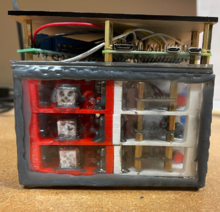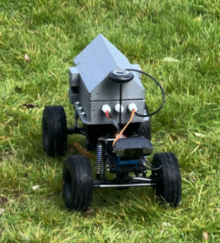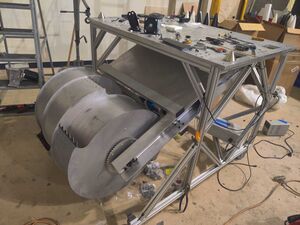Category:Mars
The SSI Mars team seeks to push the boundaries of crewed space missions and pave the way for permanent settlement of Mars and other celestial bodies. Our projects are centered on in situ resource utilization (ISRU), a broad group of technologies which make use of the scant resources on Mars for long-term surface missions. We turn Martian air and soil into fuel and concrete, eliminating the need to launch everything from Earth. At the same time, ISRU technologies can sustainably produce fuel and building materials for use on Earth, making our work a crucial step in fighting climate change. If we learn to live on the Red Planet, we can also save the blue one!
Furthermore, we are developing technologies to help explore uncharted regions of Mars, such as the planet's polar ice caps. Through the Mars Polar Rover Team, we are building a rover that will make a journey across Antarctica to set course for the South Pole on Earth. This mission will serve as a template to one day reach the corresponding polar ice caps on Mars.
It's not just Martian technology that our team works on – we are also pursuing breakthroughs on the Moon. One of our newest projects, a partnership with aerospace company Astrolab, aims to construct a prototype excavator to dig through lunar regolith for eventual human settlement and construction on the Moon.
The current Mars co-leads are
The 2022-2023 Mars co-leads were Jolene Lee and Jenny Kim.
The 2021-2022 Mars co-leads were Andrew Lesh and Kylie Holland.
The current faculty advisor for the Mars team is Dr. Michael Lepech.
IN SITU RESOURCE UTILIZATION (ISRU)
ISRU is focused on identifying sources of needed elements and materials from one’s immediate surroundings. For example, while the Martian surface is barren and desolate, its carbon dioxide atmosphere provides a source of carbon and oxygen while subsurface water ice provides a source of oxygen and hydrogen. Using electrocatalysis powered by solar panels, these two sources allow for the formation of breathable O2, methane for fueling rocket engines, and carbon monoxide for syngas. Meanwhile, Martian soil can be used as an aggregate base for concrete as well as a source for sulfur and basaltic minerals, whose significance is described below in Mars Bricks.
Teams
MARS BRICKS
The bricks subteam experiments with methods of turning Martian and lunar soil into building materials for habitats and other structures. The team works with biopolymer-bound soil composite (BSC), which is made of soil, protein binder, and water. BSC has similar compressive strength as Portland cement concrete, the world’s most common construction material. While concrete production accounts for about 8% of global CO2 emissions, BSC provides a possible carbon-neutral alternative and is also easy to produce from Martian resources. The team created a payload to autonomously create these Martian bricks in 0g (aboard the ISS), 1g (resting on Earth), and 2g (continuously spinning in a centrifuge). After winning a NASA contract, our payload was sent to the International Space Station to test it's formation in 0g. You can learn more here.
The team's most recent newsletter as of May 31st, 2023, can be found here.
MARS POLAR ROVER
The Mars Polar subteam is constructing an GPS-based autonomously-navigated rover to replicate driving conditions at the Martian polar ice caps in order to guide future NASA exploration of Mars. The long term goal is to test the rover on an expedition across Antarctica to reach the Earth's South Pole. Specifically, the rover will follow the charted South Pole Overland Traverse from coastal McMurdo Research Station to the Amundsen-Scott South Pole Station. The subteam has already built two small prototype lithium polymer battery-powered rovers with custom-designed snow tires and GPS navigational functionality via ArduPilot software. In the next stage of rover prototyping, we aim to incorporate solar panels, a Starlink installation for internet access for live control and video streaming, and a LiDAR module for object avoidance and path planning.
The team's most recent newsletter as of May 31st, 2023, can be found here.
MARS EXCAVATOR
The SSI Mars team is collaborating with Astrolab, an aerospace company, to participate in NASA's Break the Ice Challenge to develop technologies to extract lunar regolith and water. As it is difficult and expensive to transport construction materials from Earth to the moon, this excavator will dig up regolith on the moon to use as a construction material for the long-term sustainment of human life, following our team's theme of ISRU. The excavator takes up the form factor of a large toothed rotating drum attachment for a lunar rover. In order to test the excavator's effectiveness, we developed a concrete imitation of lunar regolith with similar physical and compressive qualities with help from Stanford's civil engineering faculty.
HOW TO JOIN:
Join SSI, hop on the slack, and join #mars, #mars-bricks, #mars-polar-rover, and #mars-excavator.
Feel free to ping
if you have any questions or just want to chat!
This category currently contains no pages or media.


